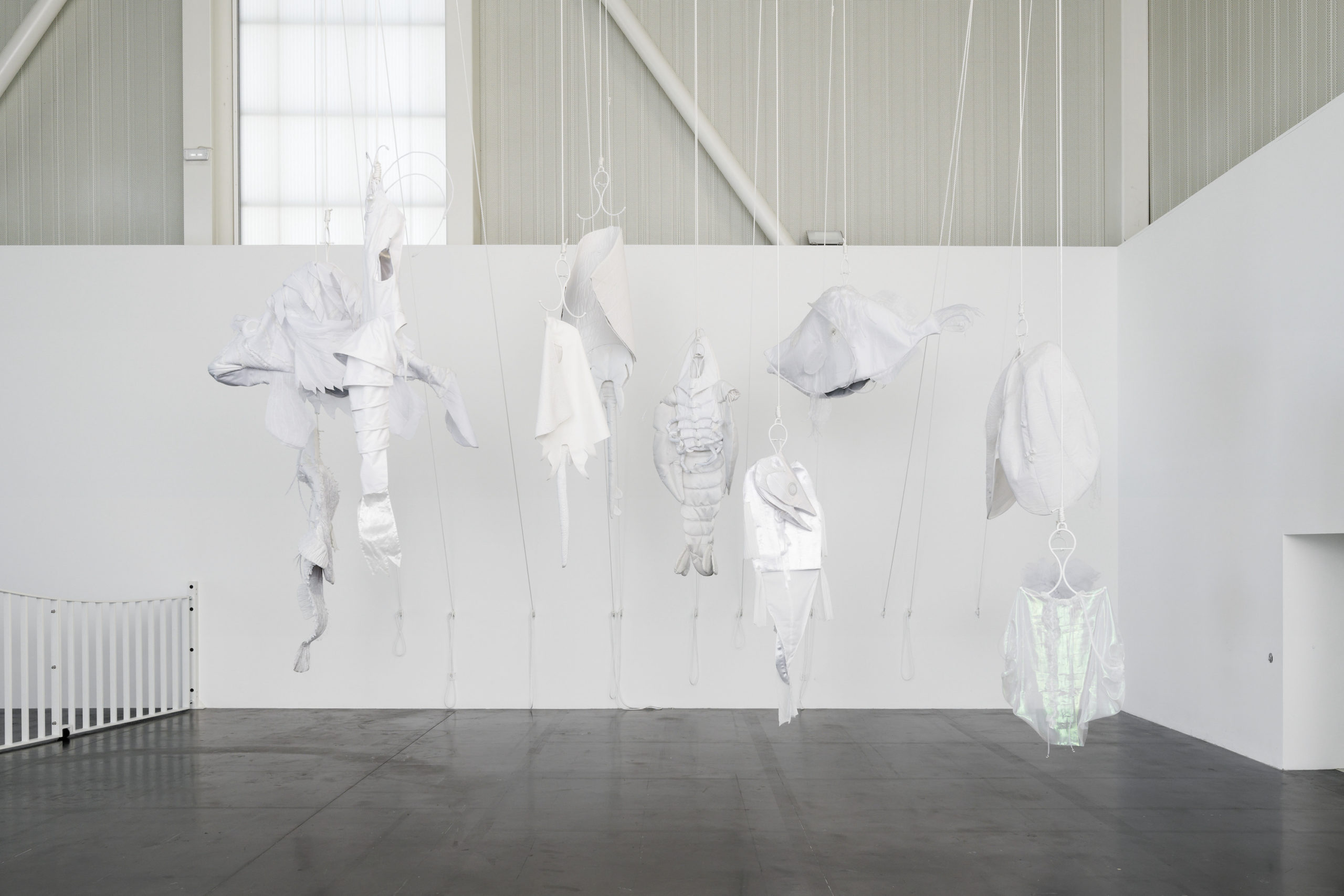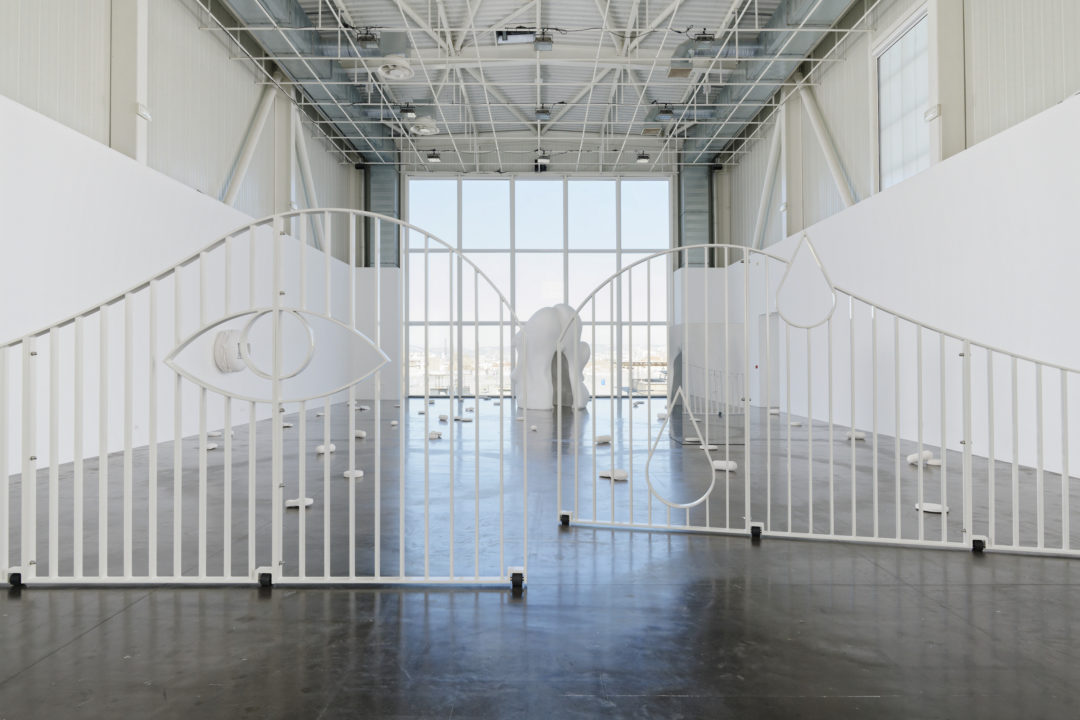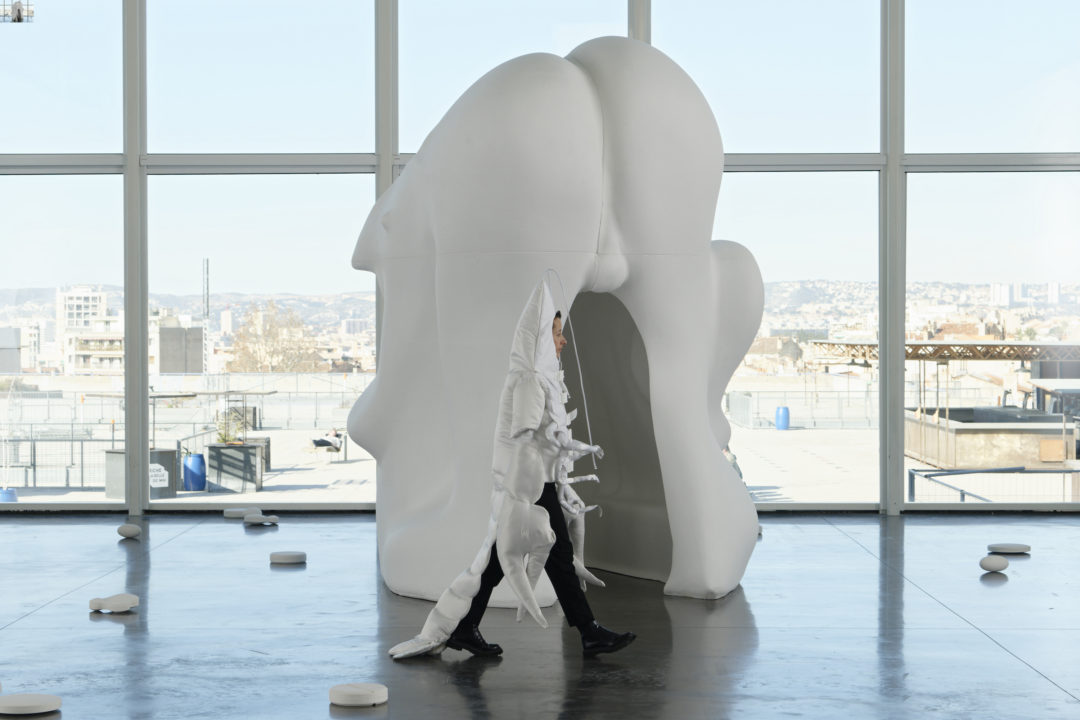Aline Bouvy at Friche Belle de Mai, Marseille

In 2024, Triangle-Astérides, a contemporary art centre of national interest, will be celebrating its 30th anniversary with an exhibition by Aline Bouvy, on show at Panorama de la Friche la Belle de Mai from 3 February to 2 June. It has been co-designed and co-produced with the Ferme du Buisson art centre, where it will be on view from 6 October 2024 to 26 January 2025.
In Marseilles, the exhibition is curated by Marie de Gaulejac, Victorine Grataloup and Thomas Conchou. Right from its title, the exhibition announces an ambiguous polysemy: “The price of the ticket”, which refers to the sum that visitors to an amusement park must pay; the said ticket is presented in a distorted, disruptive and deceptive avatar, immaculate white and silent; it also echoes sacrifice, according to the expression “paying the price”. This double is borrowed from the title of James Baldwin’s The Price of the Ticket, a collection of essays by the African-American writer.

Triangle-Astérides, centre d’art contemporain d’intérêt national en co-production avec La Ferme
du Buisson, centre d’art contemporain d’intérêt national et la SCIC Friche la Belle de Mai, et en
partenariat avec Kultur | Lx et le Ministère de la Culture du Grand-Duché de Luxembourg.
Photo : Aurélien Mole.
The exhibition is divided into two parts, delimited by a half-open white grid, from which a mouth, or an eye, and tears give a glimpse of the main space. As we enter Panorama, we are greeted by a sort of ‘vestibule’, in the words of the artist, inviting us to discover a Mediterranean fauna that includes shrimp, lobster, scorpion fish, mussels, whiting, skate and anglerfish. In an arrangement that combines different levels of interpretation, the superb pieces – created with professionals from the workshops of the Opéra de la Monnaie in Brussels – conjure up a marine imaginary, underpinned by the anchors on which the outfits are hung, extended by the organisation of the ropes that suspend them and by the marine knots in which we can guess the fisherman’s gesture, which itself refers to a theatrical landscape where the human controls and organises the game. The public is then invited to dress in these costumes to enter the second space of the exhibition, and while the device leads to genuine playful participation on the part of the spectator, it nevertheless begins to induce a posture of doubt, of embarrassment in relation to its appropriation of works of extreme finesse, which must be delicately dressed with white gloves. We’re afraid of getting dirty, and it’s this ambivalence that will govern the exhibition: this whiteness that makes us feel uncomfortable and that raises questions.
The exhibition continues past the gate that marks the entrance to the Luna Parks, which appeared in the United States at the beginning of the 20th century. According to Victorine Grataloup, these parks are “the heirs of traditional funfairs as well as universal and colonial exhibitions”. The artist has seized on the codes of these parks and exhibitions, seeing in them an echo of the white structure that is the Panorama, the only building added to the industrial wasteland in 2013, inaugurated for Marseille European Capital of Culture. Discreet until then, the disquieting energy unfolds in an accumulation of small sculptures in a round shape that mixes coins, merry-go-round tokens and medicines, even drugs. Negative hallucination, a one-way mirror booth reminiscent of an ice palace, plays with the visitor’s scopic desire, organising an optical game of superimposition around the exhibition’s main lines. The work transforms the visitor into a voyeur who consumes images. In fact, the box of handkerchiefs is reminiscent of a peep show…
Throughout the exhibition, it is the corporeal dimension that extends from the role given to visitors, to the motifs on the entrance gate, to the monumental sculpture in front of the bay window. Krypt crystallises the formless and the human, and represents a distorted, disquieting head, from which we can hear a sound piece, Il Circo Oscuro, produced with the Pierre-Barbizet Conservatoire and the Centre national de création musicale de Marseille, which is made up of sighs, whispers, onomatopoeia, cries of pleasure and fear.

Triangle-Astérides, centre d’art contemporain d’intérêt national en co-production avec La Ferme
du Buisson, centre d’art contemporain d’intérêt national et la SCIC Friche la Belle de Mai, et en
partenariat avec Kultur | Lx et le Ministère de la Culture du Grand-Duché de Luxembourg.
Photo : Aurélien Mole.
Omphaloskepsis, in the shape of a burger, condenses the elements of fiction that litter the exhibition and summons up the entertainment industry, distorting reality to turn it into a fiction of capital and whiteness. It depicts the interior of a fast-food restaurant – from the first fast-food chain, White Castle, founded in 1921 – whose broken arches give it an almost mystical dimension; and its white background, again, echoes the brand’s very strict policy of insisting on exemplary cleanliness, from the employees’ dress to the interior and exterior of the restaurant. In the model room, the artist shows a sort of storeroom where rubbish bins, dirt and other objects are piled up, in stark contrast to the aseptic white.
Putting this work into perspective with Panorama seems enlightening, if we are willing to bend the original definition of the white cube and its four white walls. In 1976, Brian O’Doherty wrote this about the formalist space par excellence that is the gallery’s “white cube”: “Something of the sacredness of the church, the formalism of the courtroom, the mystique of the experimental laboratory combines with chic design to produce this unique thing: an aesthetic chamber.” Just as the white cube conveyed the idea of timelessness and neutrality, the fast-food restaurant put forward by Aline Bouvy claims to be aseptic: but at what price? What kind of neutrality can exist when it is based solely on the theoretical and critical framework of a bourgeois consensus that rejects subaltern voices? What does this burger, which collects the symbols of an old world that, in the artist’s eyes, is nothing but decay, have to say? Borrowing James Baldwin’s title allows us to inscribe this thought about white, whiteness, of the white.
______________________________________________________________________________
Head image : Aline Bouvy, « Le prix du ticket », vue d’exposition à Triangle-Astérides, 2024.
Triangle-Astérides, centre d’art contemporain d’intérêt national en co-production avec La Ferme du Buisson, centre d’art contemporain d’intérêt national et la SCIC Friche la Belle de Mai, et en partenariat avec Kultur | Lx et le Ministère de la Culture du Grand-Duché de Luxembourg. Photo : Aurélien Mole.
Related articles
Streaming from our eyes
by Gabriela Anco
Don’t Take It Too Seriously
by Patrice Joly
Déborah Bron & Camille Sevez
by Gabriela Anco

